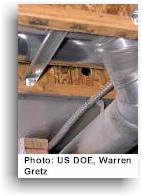

Duct Insulation
Aerosol-Based Duct Sealing
Benefits
Heating and cooling duct systems in offices typically leak 15% to 30% of the air passing through them. This air leakage impacts energy use, indoor air quality, personal comfort, and the environment.
 |
Duct Insulation Insulating ducts with insulation wrap, and sealing air leaks in ducts, can be among the most effective energy saving strategies. Air leaks are sealed using duct mastic (not tape!) wherever leaks are accessible, in attics, crawlspaces, etc, and should be sealed before adding insulation wrap. A special aerosol duct sealing system is also available in some areas to facilitate sealing leaks in inaccessible ductwork. Aerosol-Based Duct
Sealing |
Aerosol particles are directed primarily toward the leaks because:
- Small aerosol particles are kept suspended in the airflow by a fan.
- As the air stream makes a sharp turn through a leak, the particles are flung against the leak walls.
- Using sticky solid particles allows the built-up seal to span leaks as much as 1-inch across.
- All grilles are temporarily sealed, forcing all the air flow through the leaks.
- Air flow, duct pressure, and particle size are optimally controlled to maximize leak sealing.
Benefits
Sealing duct leaks reduces heating and cooling energy use by up to 30 percent and annual
utility bill savings of up to $300. Duct sealing reduces the entry of dust, excess
humidity, automotive exhaust, radon gas, and fumes from stored paints, solvents,
pesticides, etc.
Duct sealing improves the performance of heating and cooling systems, making you more comfortable by:
- Cooling or heating the office more quickly
- Delivering more hot or cold air
- Distributing heating and cooling more uniformly throughout your office
Even newer systems, that may already be insulated, may be very leaky, so don't assume they are tight just because they are insulated. It is best to have a weatherization or HVAC professional who has a duct leakage testing device test your ductwork to be sure.
Sources: Lawrence Berkeley National Laboratory
|
|

|
| Copyright Aclara Technologies LLC. All Rights Reserved. | |